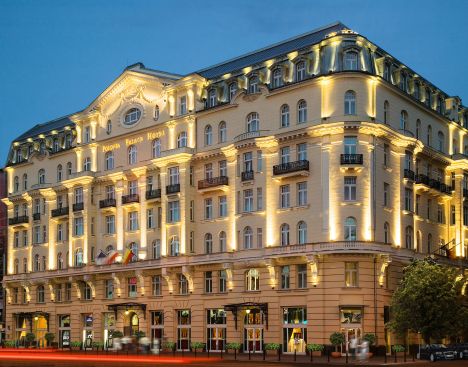
History, photos and review of the historic hotel in Poland's capital Warsaw
On July 14, 1913 the elegant Polonia Palace Hotel opened it’s doors. It remains until today one of Warsaw’s few traditional luxury hotels.
Founded by Count Konstanty Przedziecki, a member of one of Poland’s old aristocratic families, the hotel’s name “Polonia Palace” testifies to the fact that the count’s decision to create a hotel was also motivated by patriotic sentiments.
The architects Józef Holewiński and Juliusz Nagórski built the hotel in the years from 1909 to 1913. Nagórski was inspired by the style of Ecole des Beaux-Arts in Paris, one of the schools where he had studied. The interior design, ceilings and walls were decorated in Louis XVI style.
Polonia Palace offered the people of Warsaw a Parisian style experience with mansard roofs and elegant interiors in a classical French style. It was the first hotel in Warsaw providing its guests with hot and cold running water in all rooms, a state-of-the-art central heating system, laundry room and car parking facilities with heated parking spaces, dial telephones and electric clocks in all rooms. The original glory of the hotel can best be admired at Ludwikowska Ballroom.
The hotel’s location is excellent. Initially, it was situated opposite Dworzec Widenski (Vienna Train Station), which was destroyed in 1919, then opposite Dworzec Glówny (Main Station), which does no longer exist either. Today, Warsaw Centralny, the central train and bus station, is just some 300 meters away and trams stop in front of the hotel.
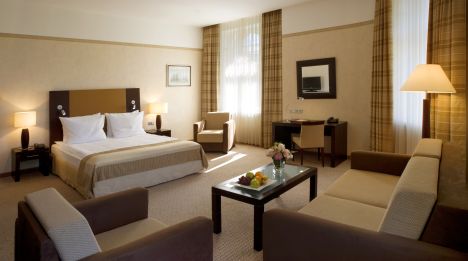
View of an Executive Room. Photos copyright © Polonia Palace Hotel.
The hotel during Warsaw’s Roaring Twenties
In 1920, H. Kozieradzki became the new hotel owner. After the First World War, in the Roaring Twenties, the luxury hotel became the place to stay and to be seen in Warsaw. In 1924, the hotel’s Palais-Dancing Restaurant opened, one of Warsaw’s most fashionable restaurants were artists, writers, politicians and diplomats met.
The Polish actor and world-famous tenor Jan Kiepura used to give concerts from the restaurant’s balcony during elegant dinner banquets. Among the hotel’s famous guests in the Roaring Twenties were also popular comedy actor Adolf Dymsza, poet, cabaret founder and songwriter Julian Tuwim, novelist and dramatist Stefan Żeromski, writer, poet and theatre critic Kornel Makuszyski and singer, film and stage actress Mieczyslawa Ćwiklińska.
Another habitué of the elegant Polonia was theatre director, critic and theoretician Leon Schiller. He ended up in the infamous Auschwitz-Birkenau concentration camp, but was bought off by his sister and later became a dogmatic communist in post-war Poland, a pillar of the Stalinist regime.
Maria Pawlikowska, a playwright and the “queen of lyrical poetry” during Poland’s interwar period, regularly visited Polonia Hotel. In 1937, she wrote the anti-totaliarian play A Woman of Wonder.
The enfant terrible of the Polish literary scene Tadeusz Boy-Żeleński also honored the luxury hotel by his presence. The pediatrician and gynecologist was an eminent translator of French classics into Polish. The liberal and democratic Boy-Żeleński mocked conservative authorities, Young Poland modernists, irrational Polish romantic traditions as well as Kraków’s bohemians. In 1933, he became a founding member of the Polish Academy of Literature, making him an insider of Poland’s leading literary institution, which fought for the Polish language and culture, largely suppressed under Prussian, German and Russian rule. The writer, poet and critic Tadeusz Boy-Żeleński was murdered in the massacre of Lviv professors during the Nazi occupation in 1941.
In 1927, the painter Kasimir Malewitsch held his first international exhibition at Polonia Hotel. In 2009, a conference room was named him; reproductions of his works and historic photos documenting his presence ornate the room.
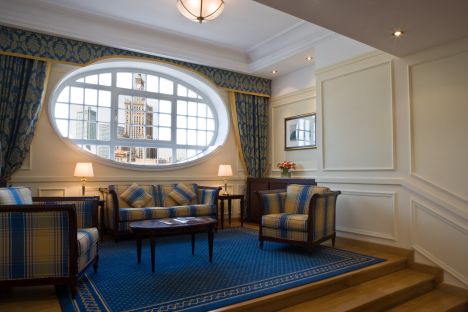
View of the entrance of the English Apartment. Photo copyright © Polonia Palace Hotel.
Wehrmacht headquarter, host of embassies, consulates and international organizations
Polonia Palace Hotel survived the Second World War virtually unscathed because it was the headquarter of the German Army (Wehrmacht) in Poland. After the war, in September 1945, General Eisenhower, cheered and welcomed by hundreds of Varsovians at Hotel Polonia, where a special banquet in his honor was organized. Among the many other politicians staying at the hotel in post-war times was Charles de Gaulle.
The U.S. Ambassador to Poland from 1944-47, Arthur Bliss Lane, stayed with his wife in a suite at Polonia Hotel, a time he remembered in a 1947 article in Life magazine, where he also wrote how “Poland was sold down the river at Yalta” and how “the Communists rigged the Polish elections”. The U.S. Embassy Staff stayed on the second or “American” floor at Hotel Polonia from 1945 to 1947.
In addition, Polonia Hotel served as Finnish Embassy from 1945 to 1945, Spanish Embassy from 1948 to 1949, Romanian Embassy from 1948 to 1949 as well as British and Swedish Embassy. Most “faithful” were the diplomats from Belgium and Egypt who stayed longest at the luxury hotel.
After the end of the Second World War, 19 countries and several international organizations such as the Red Cross and UNRRA had their (diplomatic) offices and consulates at Polonia Palace which, in addition, hosted many wartime and post-wartime correspondents; it was a spot not only for diplomacy, but also for people gathering information. The cooperation between the Embassies and the hotel still continues. Polonia Palace often host international delegations, parties on national holidays and diplomatic meetings.
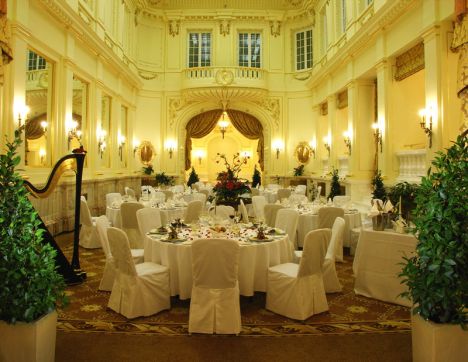
View of the Ludwikowska Ballroom. Photos copyright © Polonia Palace Hotel.
Communist times and new-glory after 1989
Since 1965, Hotel Polonia is a listed building. It is situated opposite the Palace of Culture and Science, the Stalinist building, which has dominated the Warsaw skyline since its construction from 1952-55.
In 1974, the state-owned Syrena Warsaw Tourism Enterprise was established as the owner of Polonia and Metropol hotels. During the difficult communist times, hotel staff and management tried to upheld the hotel’s four star standard. After the end of communism in 1989, a new era began.
In 1997, the Austrian Bau Holding AG from Vienna, owned by Strabag (51%) and Raiffeisen Centrobank (49%), bought Syrena for $24 million. Subsequently, they renovated the flagship hotel of the group for €30 million and reopened the elegant Polonia Palace Hotel on March 31, 2005 after a two-year renovation. The hotel remains part of Syrena Hotels.
As many properties in Eastern Europe, which have nationalized during Communist times, Polonia Palace is the object of a restitution claim. Maria Jolanta Lubomirska-Pierre, the granddaughter of Konstanty Przeździecki, demanded the restitution of the property. At the beginning of 2014, the lawsuit has still not been settled.
As a guest, you don’t care about the legal battle, but enjoy the comfort and service of the fully restored hotel, which offers great value for money.
At the end of 2013, I stayed in the spacious Deluxe Room 604. I appreciated the fact that the hotel was almost fully booked. The bar, the restaurant and even the lobby were always busy. It was never boring at the hotel. In addition , the very large breakfast was excellent and the gym was open 24/7.
Details make a difference: I appreciated the do-not-disturb sign, which is red on both sides. There can be no misunderstanding with signs that fall on the ground and cleaning ladies who do not know whether they should clean the room or respect the privacy.
Large Samsung flatscreen TVs and tea and coffee making facilities as well as complimentary tea and coffee are standard in all rooms. The chairs and tables throughout the hotel – with the exception of the English apartment, which has a unique design – are made of beech and alder wood from Meble Roja. The beds come from an Austrian company. The wool carpets are made by Kowary. The ceramic sinks and the toilets are Swiss made by Laufen. The amenities were by the Swiss luxury company Chopard.
Last but not least, I can recommend a visit to the hotel’s Strauss Restaurant with chef Grzegorz Golen, especially during the asparagus season in May and June!
Books about Warsaw from Amazon.com, Amazon.co.uk, Amazon.fr and Amazon.de.

The historic façade of the Polonia Palace Hotel. Photo copyright © Polonia Palace Hotel. Books about Warsaw from Amazon.com, Amazon.co.uk, Amazon.fr and Amazon.de.
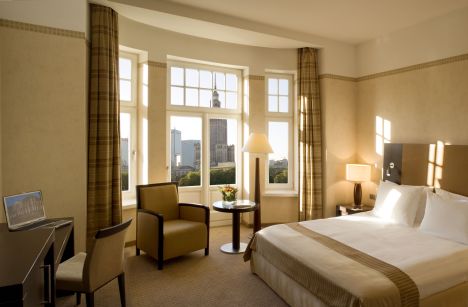
A Deluxe Business Room. Photos copyright © Polonia Palace Hotel.
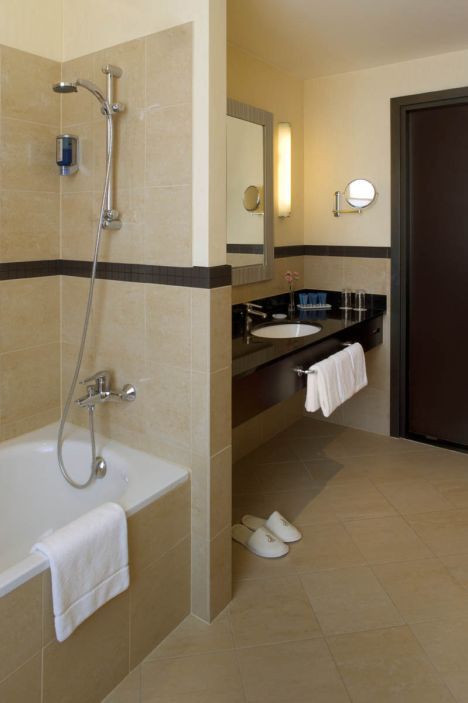
View of a bathroom. Photo copyright © Polonia Palace Hotel.

View of the gym with Technogym equipment. Photos copyright © Polonia Palace Hotel.